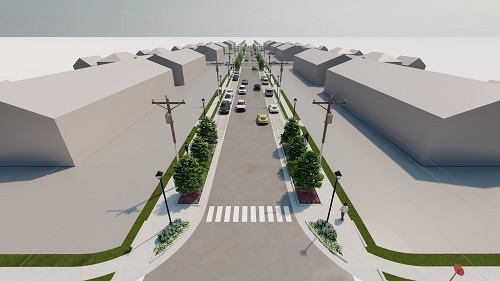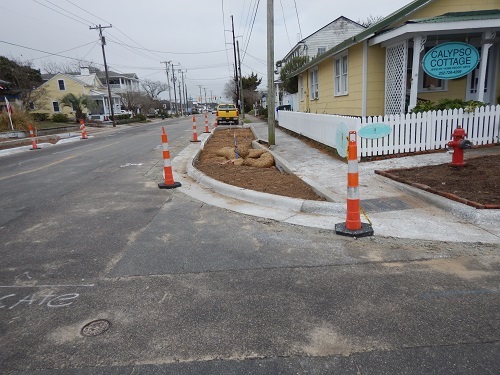The North Carolina Department of Transportation is managing an innovative drainage project that captures storm-water runoff while addressing chronic flooding in a historic, coastal neighborhood.
[Above photo by NCDOT]
Cedar Street in Beaufort, NC, carries two lanes of traffic and off-street parking through a mix of residential and small businesses in this 310-year-old town. Because Beaufort is on the coast, untreated stormwater runoff easily flows into the estuary as the town’s current drainage system can’t hold up to flooding from hurricanes, tropical storms, or even heavy rain.
There isn’t enough room for a larger drainage system, so NCDOT turned to what are called “bio-retention cells” – concrete borders or “bump-outs” along the street that will filter stormwater before it enters the estuary. Those “bump-outs” funnel water to 14 collection areas that resemble planter boxes, where the water will be filtered before it enters a newly rebuilt storm-water main along Cedar Street.
To facilitate drainage, the town of Beaufort will use permeable pavement to rebuild the parking lanes on the street. The pavement should reduce runoff and filter pollutants from getting into the estuary.
NCDOT has used bump-outs before, but not in an urban setting, noted Andrew Barksdale, an agency spokesman. Because of the compact development along the street, the bump-outs seemed like a good application.

“The existing infrastructure and development along this road presented a challenge with building a traditional drainage system,” NCDOT engineer Jeff Cabaniss said in a statement. “This alternative system will be better for the environment and also contribute to the beautification of this historic town and improve its water quality.”
Cedar Street was a major thoroughfare before a high-rise bridge just north of the small town claimed the U.S. 70 designation and most of the traffic, but Beaufort still attracts tourists. Locals are proud of the area’s colonial history and are especially happy that ownership of Cedar Street will pass to the town when the project is completed.
“This project is a more economically friendly approach, which helps the town because we have been trying to clean up the estuary,” said Rachel Johnson, a public information officer for Beaufort. “When it’s done, this will be a town-owned project.”
Construction of the bio-retention cells is estimated at $925,000, with the resurfacing about $400,000, NCDOT’s Barksdale noted. The town of Beaufort is using state grant money to rebuild the parking lanes and expects to complete construction on this project by summer.
This is but one of several NCDOT flood-control initiatives occurring statewide.
For example, in May 2022, NCDOT activated a new flood-warning system that relies on a network of 400 river and stream gauges to help analyze, map, and communicate in real-time any flood risks to roads, bridges, and culverts.
That critical information goes to NCDOT maintenance staff responding to flooded roads and washed-out culverts yet also benefits local emergency management officials and the public accessing the department’s DriveNC.gov website for timely weather-related closures. “This state-of-the-art warning system our department has created will help us be better prepared for the next major storm,” explained Eric Boyette, NCDOT secretary, in a statement at the time. “Even though we’ve had some quiet hurricane seasons recently, we cannot let our guard down.”

